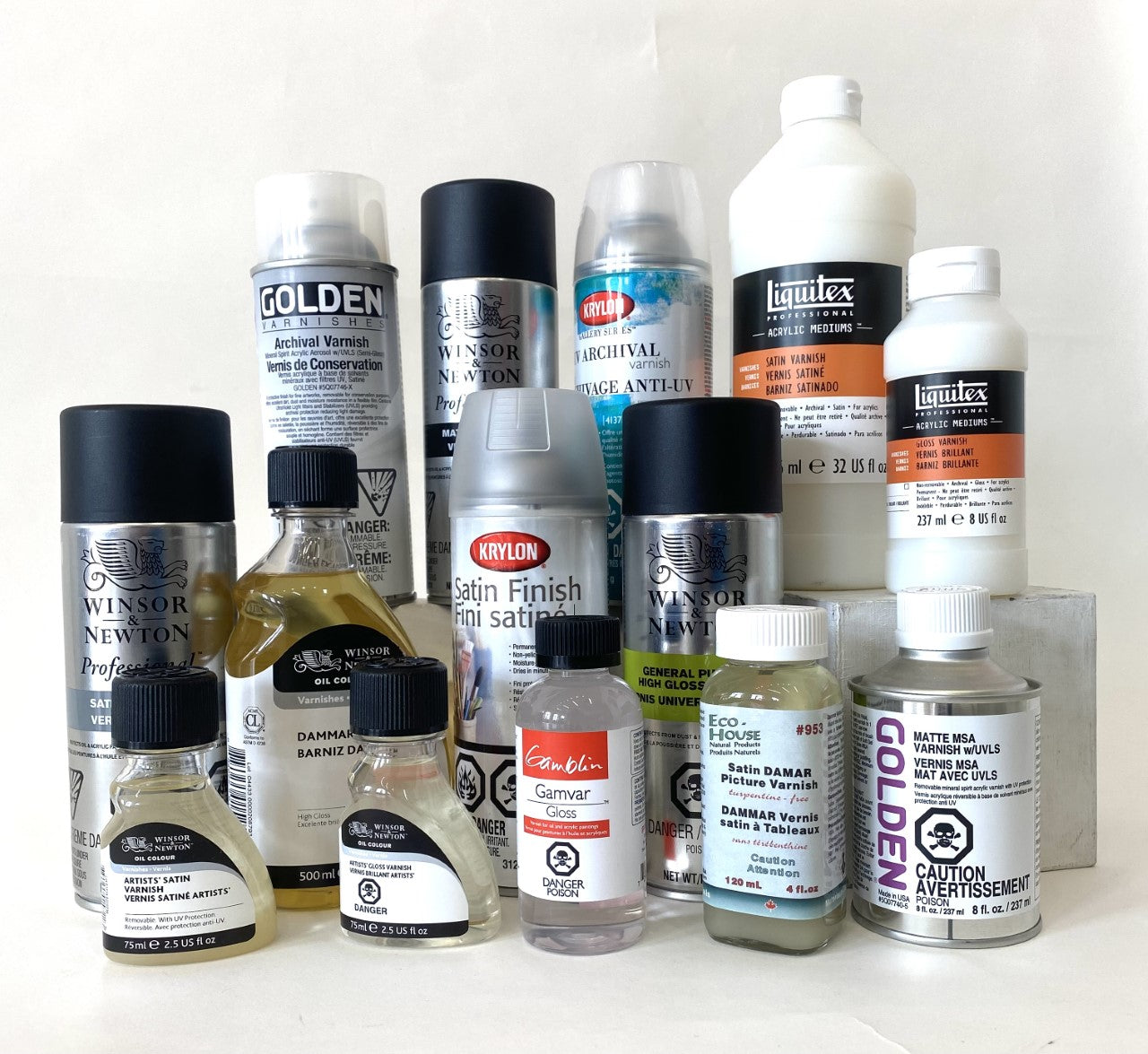People often ask us about varnishing their paintings, and while yes, it's (almost) always a good idea to varnish, there are many factors to consider when making the decision; which products are best, and when and how to go about it.
Why varnish?
For many people, the issue of the appearance of a finished painting is their primary motivation, and they may not be bothered if their work outlives them or not. But for those who are concerned about the longevity of their artwork, varnish is the simplest way to both enhance and protect their work.
What is varnish?
Varnishes are comprised of various types of resin, either water- or solvent-based, some derived from plants and others synthetic or petroleum based. Varnishes provide a protective barrier over the surface of a painting, offering modest protection against impact and scratching, but excellent protection against dust and moisture, and in the best case, added UV protection. The varnish resin sets up to a harder, less porous film than the paint, making it less receptive to dirt and moisture, and easier to clean.
When to Varnish?
Most acrylic paintings will be thoroughly dry and ready to varnish in a few days, unless the weather is very humid or your paint is very thick. Oil paintings will take longer be fore they are ready for varnish. A popular rule of thumb has been to wait 6 months before varnishing oils, but that can vary wildly, from a few weeks to a year or more in extreme cases. Oil colour dries by oxidation unlike acrylic which dries by evaporation. Different oil colours oxidize at different rates and are more or less dry/oily, so it's not uncommon for parts of an oil painting to take longer than others to fully cure. Diluting oil colour with solvents, or using quick-dry additives will also shorten the drying time.
What Finish is Best?
Varnishes can affect the level of sheen and clarity, colour brilliance and can unify surfaces for a consistent appearance. Gloss varnishes help make colour pop, but can cause glare, matte varnishes eliminate glare but can reduce colour intensity, and satin or semi-gloss varnishes balance the two effects. The choice of sheen on a piece is subjective, and different paintings may look better with different finishes.
Removing Varnish
Over time, varnish might become dirty, scratched, or discoloured depending on the environment. Most professional picture varnishes are removable, allowing the artist or a conservator the option of removing the varnish layer to retouch, repair, or refinish a piece. Some varnishes are permanent, and will afford the same protection as removable varnishes, but without the option to 'strip' and refinish the painting. Oil or solvent-based varnishes are typically removed with a mineral spirit or turpentine, and water-based polymer varnishes are removeable with an ammonia solution.
Applying Varnish
Applying varnish can be a daunting prospect, but with a bit of practice (on test scraps!) most artists figure out the method that works best for them. Varnishes are available in brush- or spray-on formats. Spray varnish is handy for smaller paintings, but it can be tricky to get even coverage over larger surface. Expect to do at least 2-3 coats of spray varnish for a consistent finish. Brush-on varnishes leave a more generous coat than sprays, and often two coats its adequate. You will want a nice quality soft flat varnish brush for the smoothest application, and the appropriate solvent (water, mineral spirits etc) if brushing.
You can re-coat most varnishes every few hours, sooner with spray. As you apply each coat, watch for drips and runs (much easier to fix when brushing) and check against the light to ensure even coverage. It's a good idea to plan out your varnishing and drying areas ahead of time so that there is a safe place for wet work, especially if you are doing a number of paintings at once. If your workspace is dusty, it's a good idea to do a cleanup before varnishing to reduce the chances of airborne pollutants landing in your wet varnish.
Health and safety.
Varnish solutions are quite dilute to allow for smooth and even application, and because of this there is a fair bit of solvent that gasses off as they dry. Aerosols put mists of resin as well as solvent into the air, and extra respiratory protection is recommended. This means that ventilation is important to consider when varnishing, and could be a combination of a respirator, fans, open windows, containment etc.
In Summary
As we mentioned at the start, it really is up to you whether you varnish a painting or not. You may be perfectly content to leave your work unvarnished, or maybe you intend to varnish at some point in the future and that's perfectly fine. But if and when you are ready to varnish, we've got you covered!


1 comment
Laura Waldie
Thank you so much for this great breakdown of the various varnish options out there. I’m still figuring out which varnishes to use so this article has been very helpful! Thanks WAS staff!